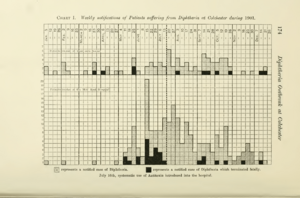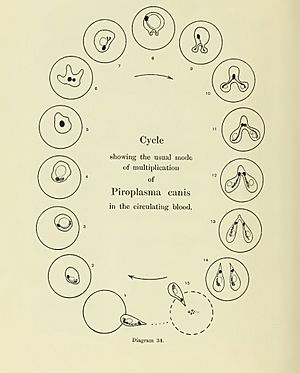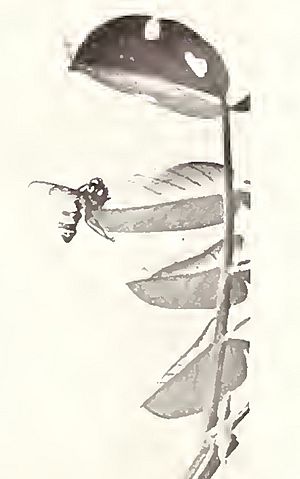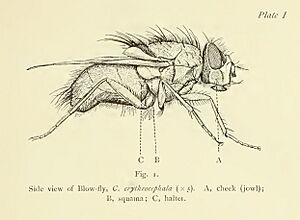George Stuart Graham-Smith facts for kids
George Stuart Graham-Smith (born September 25, 1875 – died August 30, 1950) was a British scientist. He was a pathologist, who studies diseases, and a zoologist, who studies animals. He is best known for his important work on flies. He studied how flies spread diseases and also learned a lot about flies themselves.
Contents
Early Life and Education
George Stuart Graham-Smith was the son of an army colonel. He went to Clifton College and then studied at Pembroke College, Cambridge. He enjoyed playing cricket there. In 1897, he earned his first degree.
He then went on to study medicine at Guy's Hospital in London. By 1901, he had become a doctor. He returned to Cambridge to study diseases more deeply. In 1904, he received a special scholarship for research in pathology. He earned his M.D. degree in 1905.
Studying Diphtheria Outbreaks
In 1901, Graham-Smith was learning about diseases in Cambridge. A serious disease called diphtheria broke out nearby. He helped his teacher, Louis Cobbett, study the outbreak. They worked to find the germs, test animals, and help sick people.
Later that year, diphtheria spread in Colchester. Graham-Smith went there to help. His work in Colchester became part of his first published paper. He described how they stopped the disease. This included giving patients a special treatment called antitoxin. They also tested people and kept sick people separate. Schools were closed and only healthy students could return. The outbreak ended in the autumn of 1901.
Graham-Smith continued to study diphtheria for several years. He published papers about how the disease spread. He showed that it was important to test how strong the germs were. He found that dangerous germs were rarely in healthy people. This meant that separating and testing people who had been near sick patients was a good idea.
Working with George Nuttall
Graham-Smith worked closely with another scientist, George Nuttall. Together, they edited a major book about diphtheria in 1908. This was the first big book on the topic in Britain.
They also studied a parasite called Piroplasma canis, now known as Babesia canis. This parasite infects the red blood cells of dogs. It is spread by ticks. Graham-Smith found that infected red blood cells gathered in tiny blood vessels called capillaries. He also discovered a new infection in moles. The germ was named Grahamella in his honor, but it is now called Bartonella.
Graham-Smith and Nuttall also worked on a project about how different animals are related. They used blood tests to see how similar animal groups were. This work, published in 1904, helped start the modern field of molecular systematics. This field uses tiny parts of living things to understand how they are related.
In 1907, Graham-Smith became a lecturer at Cambridge University. He taught about health and hygiene. In 1923, he took over from Nuttall as the Reader in Hygiene.
Research on Flies
Graham-Smith's research on flies became his main interest. He studied flies both as carriers of disease and as interesting creatures themselves. His first reports showed that flies in nature could pick up germs. He also showed that infected flies could spread germs to food.
He then studied how flies look, how their bodies work, and how they behave. He also looked at their role in human diseases. He even studied diseases and parasites that affect flies.
He closely watched a fungal disease called Empusa disease. This fungus grows inside a fly's body. The infected fly often sticks to a leaf, usually by its head. The fungus then digests the fly's body and spreads its spores.
Graham-Smith also studied other insects that are parasites of flies. These insects lay their eggs inside fly larvae or pupae. He found that these parasites were common. He also studied how the wasp Melittobia acasta lays its eggs.
In the early 1900s, summer diarrhea was a big problem, especially for children. Many people died from it. Some thought the heat caused it directly. Others thought the heat increased flies, which then spread the disease. Graham-Smith wrote a chapter about summer diarrhea in his 1913 book, Flies in relation to disease : non-bloodsucking flies.
He looked at all the evidence, including his own studies of bacteria on wild flies. He concluded that flies were very likely linked to summer diarrhea. However, he noted that it was not clear where the flies got the infection.
Later, he found more evidence. After World War I, deaths from summer diarrhea went down. Graham-Smith showed that the death rate matched the number of horse-drawn vehicles. As fewer horses were used, there was less horse manure. This strongly suggested that horse manure was a main source of the infection spread by flies.
Teaching and Other Roles
Graham-Smith was a dedicated teacher throughout his career. He taught about bacteria and public health. He also had important administrative jobs at Cambridge University. From 1939, he was the editor of the Journal of Hygiene, a scientific publication.
Honors
In 1919, George Stuart Graham-Smith was elected a Fellow of the Royal Society. This is a very high honor for scientists in the UK.
Personal Life and Death
In September 1910, Graham-Smith married Violet Leith-Ross. He died suddenly in Cambridge on August 30, 1950. He was survived by his wife and son.







